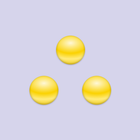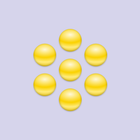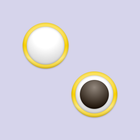Diameter, Surface Area, and Volume
Nanoparticles have unique properties due to their small size. All nanoparticles regardless of their chemical constituents, have surface area:volume ratios that are extremely high (see the following table). Thus, many of the physical properties of the nanoparticles such as solubility and stability are dominated by the thenature of the nanoparticle surface.
| Nanosphere Diameter (nm) | Surface area (nm2) | Volume (nm3) | Ratio Surface Area:Volume |
|---|---|---|---|
| 10 | 314 | 523 | 0.60 |
| 20 | 1260 | 4190 | 0.30 |
| 30 | 2830 | 14100 | 0.20 |
| 40 | 5030 | 33500 | 0.15 |
| 50 | 7850 | 65500 | 0.12 |
| 60 | 11300 | 113000 | 0.10 |
| 70 | 15400 | 180000 | 0.09 |
| 80 | 20100 | 268000 | 0.08 |
| 90 | 25400 | 382000 | 0.07 |
| 100 | 31400 | 523600 | 0.06 |
For comparison, a regulation size baseball has a diameter of 73,000,000 nm, a surface area of 16,800,000,000,000,000 nm2, and a volume of 204,000,000,000,000,000,000,000 nm3. The surface area to volume ratio is 0.00000008, a factor of 7,500,000 less than 10 nm nanoparticles.
While high surface area to volume ratios are important for applications such as catalysis, the actual properties of gold are different at the nanoscale. For example, the plasmon resonance of spherical gold nanoparticles results in the particle’s exceptional ability to scatter visible light.
Shape and Crystallinity
Gold nanoparticles can be produced with various sizes and shapes depending on the fabrication method. Typically anisotropic shapes are formed in the presence of a stabilizing polymer that preferentially binds to one crystal face and results in one crystal direction growing faster than others. The size of the crystalline domains within a nanoparticle is dependent on the fabrication method. At nanoComposix we have developed methods for minimizing the size of crystalline domains within our spherical nanoparticles to yield less variation in their spectral properties.



Nanoparticle Surface
One of the most common questions that we receive is “What is on the surface of your nanoparticles?” In solution, molecules associate with the nanoparticle surface and these surface bound molecules establish a double layer of charge that prevents nanoparticle aggregation. NanoXact and Biopure gold nanoparticles are capped with citrate, tannic acid, or PVP capping agents. Citrate weakly associates with the nanoparticle surface and is often used because the weakly bound capping agent provides long term stability and is readily displaced by a range of other molecules including thiols, amines, polymers, antibodies, and proteins.
Tannic acid is a multidentate capping ligand that can be displaced with many thiol containing molecules. Tannic acid is often used as a capping agent in applications where high particle concentrations are required.
Polyvinylpyrollidone (PVP) is a polymer that binds strongly to the gold nanoparticle surface. It provides greater stability than citrate or tannic acid capping agents, but is more difficult to displace.



It is important to remember the surface of most nanoparticles is dynamic and is strongly influenced by the local environment. Different conditions will affect the particle in different ways. High salt environments will collapse the double layer and cause nanoparticle aggregation. Proteins and other biomolecules will often associate with and stabilize particles. When working with nanoparticles you must anticipate changes to the surface and plan accordingly. For example, when nanoparticles are to be functionalized with biomolecules, it is best to expose the particles to the biomolecule in a low-salt solution, and then add salt to bring the solution up to isotonic conditions. This allows the protein to bind to the particle surface and further stabilize the nanoparticle before salt is added. If the nanoparticles are added directly to a high salt buffer, the particles may aggregate before protein stabilization can occur.
At nanoComposix we have experience fabricating particles with specific surface states, exchanging one surface for another, and constructing multiple layers of different surface molecules or shells on various nanoparticle cores. For more information please visit our Custom Synthesis page.
Particle Stability
Preventing nanoparticle aggregation can be very challenging depending on the application. Nanoparticles are either charge stabilized or sterically stabilized. For charge stabilized particles, the zeta potential is a measure of the particle’s stability. Typically, nanoparticles with zeta potentials greater than 20 mV or less than -20mV have sufficient electrostatic repulsion to remain stable in solution. However, it is important to note that the surface bound molecules on nanoComposix’s NanoXact and BioPure gold nanoparticles are easily displaced, and the zeta potential is highly responsive to other molecules or contaminants in solution. An unwashed pipet tip may introduce sufficient material to displace the ionically bound stabilizing molecules and destabilize the particles. Highly acidic or basic solutions can also increase the dissolution rate of the nanoparticles into an ionic form that can re-deposit onto existing nanoparticles changing the average diameter and size distribution.
Particle stability can be accurately tracked using UV-Visible spectroscopy or Dark Field Microscopy (see Optical Properties for more information), as well as Dynamic Light Scattering.
Surface Chemistry and Functionalization
Gold nanoparticles can be functionalized with a wide range of materials. Polymers such as polyvinylpyrrolidone (PVP) and tannic acid are capping agents typically used to stabilize gold nanoparticles. Gold nanoparticles used in biological applications are commonly coated with polyethylene glycol (PEG), bovine serum albumin (BSA), or numerous other proteins, peptides, and oligonucleotides. Binding molecules to a gold surface can be accomplished by physadsorption or by taking advantage of extremely stable thiol-gold bonds. Particles can be functionalized with molecules that 'flip' the surface charge of the negatively charged gold nanoparticles to a positively charged surface. Particles can also be functionalized to provide reactive groups (for example, amine- or carboxy-terminated surfaces) for subsequent conjugation by the customer. Dielectric shells (for example, silica, aluminium oxide, and TiO2) with a precisely controlled thickness can be used to encapsulate the particles, change the optical properties, or incorporate fluorescent dyes. NanoComposix provides a wide range of custom modifications to nanoparticle surfaces.
NanoComposix Biopure and NanoXact gold nanoparticles are offered with either citrate or tannic acid as a capping agent. Citrate stabilized nanoparticles have a surface that is readily displaced by other biomolecules or polymers and is the capping agent of choice when physadsorption is to be used to further modify the nanoparticle surface. Tannic acid is a multidentate capping agent, and it often requires the formation of highly stable thiol-golds bonds to displace tannic acid with other molecules. Tannic acid coated nanoparticles are more stable in higher ionic strength solutions and have a wider pH tolerence. Both citrate and tannic capped gold nanoparticles are stable for at least 6 months if stored at 4°C away from light. For more information, please see the custom nanoparticle fabrication section of our website.
Measuring Gold Nanoparticle Concentration
Different commercial vendors report concentration using various methods. When researching which nanoparticles to purchase and use it is critical to be able to compare formulations from different suppliers. There are a number of different ways that the concentrations are reported. Here we provide tables converting our gold nanoparticle formulations into other commonly reported concentration units.
Nanoxact Gold Nanoparticles
| Size (nm) |
Mass Concentration (mg/mL) |
Atomic (Au) Molarity (mmol/L) |
Particle Concentration (particles/mL) |
Au Mass Percent (%) |
Max Optical Density (cm-1) |
Peak Wavelength (nm) |
|---|---|---|---|---|---|---|
| 5 | 0.05 | 0.254 | 3.95 x 1013 | 0.005 | 0.80 | 520 |
| 7 | 0.05 | 0.254 | 1.44 x 1013 | 0.005 | 0.82 | 520 |
| 10 | 0.05 | 0.254 | 4.94 x 1012 | 0.005 | 0.82 | 520 |
| 12 | 0.05 | 0.254 | 2.86 x 1012 | 0.005 | 0.83 | 520 |
| 15 | 0.05 | 0.254 | 1.46 x 1012 | 0.005 | 0.83 | 520 |
| 17 | 0.05 | 0.254 | 1.01 x 1012 | 0.005 | 0.84 | 520 |
| 20 | 0.05 | 0.254 | 6.18 x 1011 | 0.005 | 0.85 | 520 |
| 30 | 0.05 | 0.254 | 1.83 x 1011 | 0.005 | 1.1 | 520 |
| 40 | 0.05 | 0.254 | 7.72 x 1010 | 0.005 | 1.1 | 520 |
| 50 | 0.05 | 0.254 | 3.95 x 1010 | 0.005 | 1.5 | 525 |
| 60 | 0.05 | 0.254 | 2.29 x 1010 | 0.005 | 1.6 | 530 |
| 70 | 0.05 | 0.254 | 1.44 x 1010 | 0.005 | 1.6 | 535 |
| 80 | 0.05 | 0.254 | 9.65 x 1009 | 0.005 | 1.6 | 545 |
| 90 | 0.05 | 0.254 | 6.75 x 1009 | 0.005 | 1.3 | 555 |
| 100 | 0.05 | 0.254 | 4.94 x 1009 | 0.005 | 1.0 | 555 |
BioPure Gold Nanoparticles
| Size (nm) |
Mass Concentration (mg/mL) |
Atomic (Au) Molarity (mmol/L) |
Particle Concentration (particles/mL) |
Au Mass Percent (%) |
Max Optical Density (cm-1) |
Peak Wavelength (nm) |
|---|---|---|---|---|---|---|
| 5 | 1.0 | 5.08 | 7.00 x 1014 | 0.1 | 16.0 | 520 |
| 7 | 1.0 | 5.08 | 2.88 x 1014 | 0.1 | 16.4 | 520 |
| 10 | 1.0 | 5.08 | 9.88 x 1013 | 0.1 | 16.4 | 520 |
| 12 | 1.0 | 5.08 | 5.72 x 1013 | 0.1 | 16.6 | 520 |
| 15 | 1.0 | 5.08 | 2.92 x 1013 | 0.1 | 16.6 | 520 |
| 17 | 1.0 | 5.08 | 2.02 x 1013 | 0.1 | 16.8 | 520 |
| 20 | 1.0 | 5.08 | 1.24 x 1013 | 0.1 | 16.9 | 520 |
| 30 | 1.0 | 5.08 | 3.66 x 1012 | 0.1 | 22.1 | 520 |
| 40 | 1.0 | 5.08 | 1.54 x 1012 | 0.1 | 22.6 | 520 |
| 50 | 1.0 | 5.08 | 7.90 x 1011 | 0.1 | 29.1 | 525 |
| 60 | 1.0 | 5.08 | 4.58 x 1011 | 0.1 | 31.8 | 530 |
| 70 | 1.0 | 5.08 | 2.88 x 1011 | 0.1 | 31.8 | 535 |
| 80 | 1.0 | 5.08 | 1.93 x 1011 | 0.1 | 31.5 | 545 |
| 90 | 1.0 | 5.08 | 1.36 x 1011 | 0.1 | 26.4 | 555 |
| 100 | 1.0 | 5.08 | 9.88 x 1010 | 0.1 | 20.1 | 555 |
At nanoComposix the mass concentration is measured using ICP-MS and UV-Visible spectroscopy.




